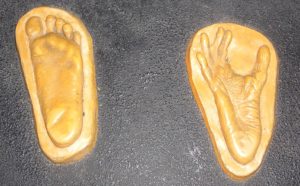The human foot is a strong and complex mechanism containing 20 bones, 33 joints, and more than 100 muscles, tendons, and ligaments. Twenty of the joints are articulated. An adult human normally has 206 total bones in his body so that means that one-fifth of all the bones in a human are in the feet.
The scientific names for the major bones of the human foot are:
1. Phalanges which are the toes.
2. Metatarsals which are the bones in the middle of the foot.
3. Cuneiforms which are the three bones in the middle of the foot toward the center of the body.
4. Cuboid which is the bone sitting adjacent to the cuneiforms on the outside of the foot.
5. Navicular which is the bone behind the cuneiforms.
6. Talus which is also called the ankle bone and is located directly behind the navicular bone.
7. Calcaneus which is also called the heel bone and is the largest bone in the foot.
Mechanical engineers have devoted decades of effort and millions of dollars attempting to duplicate the machinery of the human foot for prostheses, robots, and other applications. While great advances have been made in this effort, it is safe to say that the God-engineered human foot is still the top overall design. It will be some time before man will be able to even approximate the self-healing capabilities of any living organism.
The human foot mechanism comprises all of the following engineered functions:
1. Like an arch in a bridge, the arches of the feet allow for the support of a relatively large weight on a small surface area.
2. The foot has the ability to act as a lever so as to pivot for activities such as operating the foot pedal on a piano or the gas pedal in a car.
3. The human foot acts as a vertical lift so we can rise up onto our tiptoes.
4. The bones, muscles, and ligaments work together to act as a catapult when we jump.
5. Human feet act as cushions when we walk or run. (The skin on the soles of the feet is denser than any other skin in the human body.)
Indications are that the human foot was designed as it is in the beginning. Fossil human feet are found to be pretty much identical to the feet of those of us existing today. There is not a single anatomical change found in any human fossil footprints that would indicate man has changed over time. The foot is a “postural structure” meaning that it cannot undergo change without detrimentally affecting every part of the body that relates to posture. This fact by itself counters the idea that man has evolved over deep time.
Humans are bipedal. This is a characteristic that exists only in humans and is the most distinctive structural attribute separating humans from animals. All parts of the human skeleton are clearly engineered for bipedalism. Another way to examine the unique design of the human foot is to consider it to have five primary components as seen in the image below:
What we see in the diagram above are 1. Ankle. 2. Heel. 3. Instep. 4. Metatarsals. 5. Toes. As a human walks there is with each step a smooth progression of load movement from one component part to the next in a manner not seen in any other vertebrate. In the human foot the big toe is critical for allowing for the characteristic forward motion of the human step, run, and jump. Ape feet do not allow for this as their big toes are designed primarily for climbing and grasping as see in the figure below, with human footprint on the left and ape on the right.
This difference between apes and man is made clearer in the diagram below that shows how the weight is transferred along the foot when moving. The ape does not use the big toe (actually a “thumb”) when progressing in a walking motion as does the human.
The human heel is much larger than that of any ape, fossil or extant. While some animals can move while standing upright on their two hind feet (and so are considered bipedal), they can do so only for short periods of time and generally prefer the quadrupedal orientation.
Judkins has written, “So has bipedalism then evolved from the quadrupedal gait of apes as evolutionists claim? Of course not. Research has shown that the evolution of bipedalism never occurred, nor is it possible for it to have done so. First of all, bipedalism is not evolutionary advantage. The way in which apes move is much easier, faster, and more efficient than man’s bipedal stride. Man can neither move by jumping from tree to tree like a chimpazee, nor run like a cheetah. On the contrary, since man walks on two feet, he moves much more slowly on the ground. For the same reason, he is one of the most unprotected species in nature in terms of movement and defense. According to the logic of evolution, apes should not have evolved to adopt a bipedal stride; instead humans should have evolved to become quadrupedal.”*
Nevertheless, in conclusion, God has engineered man to walk upright, and in union with his superior brain and the image of his maker, he is the only creature with the ability and authorization to have dominion on earth. The human feet in conjunction with the other structural components of the body do a masterful job of accomplishing efficient support, balance, and mobility. To God be the glory!
J.D. Mitchell
*Judkins, Aaron, The Global Phenomenon of Human Fossil Footprints in Rock, 2009, Maverick Publishing, p. 265.





